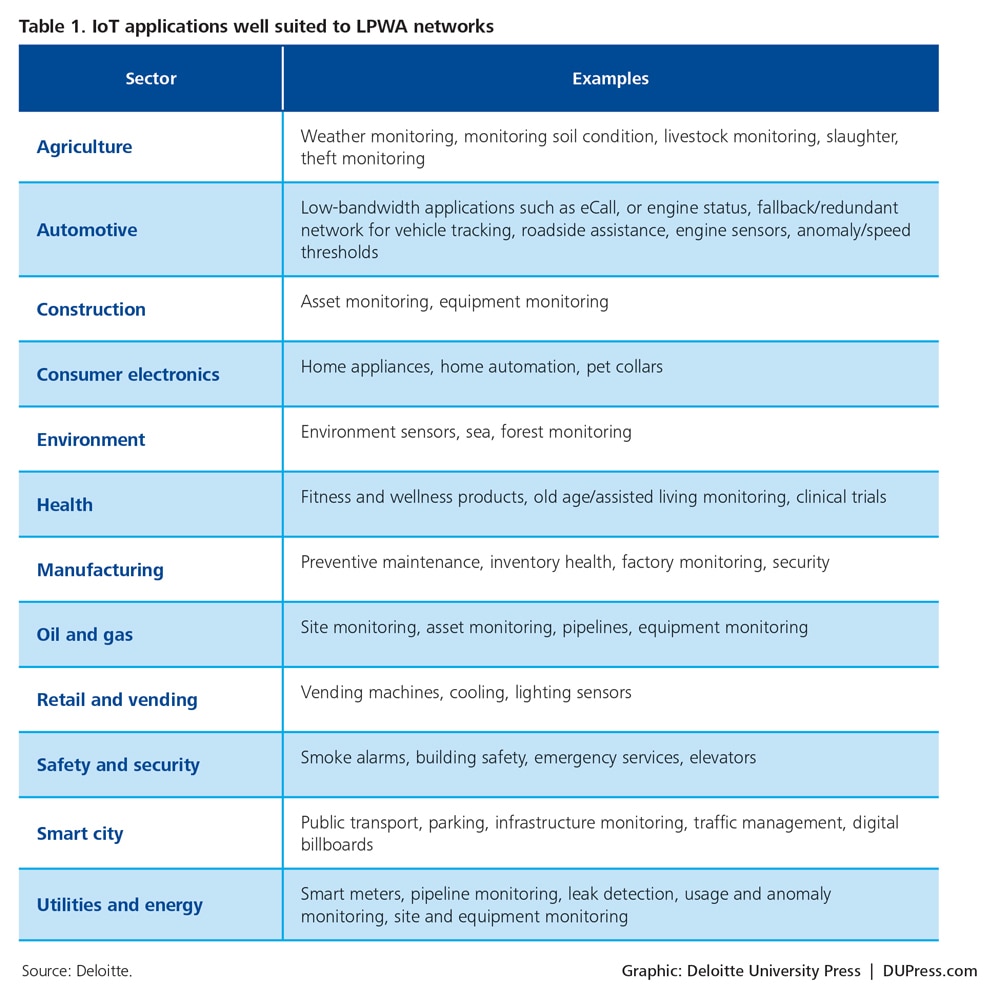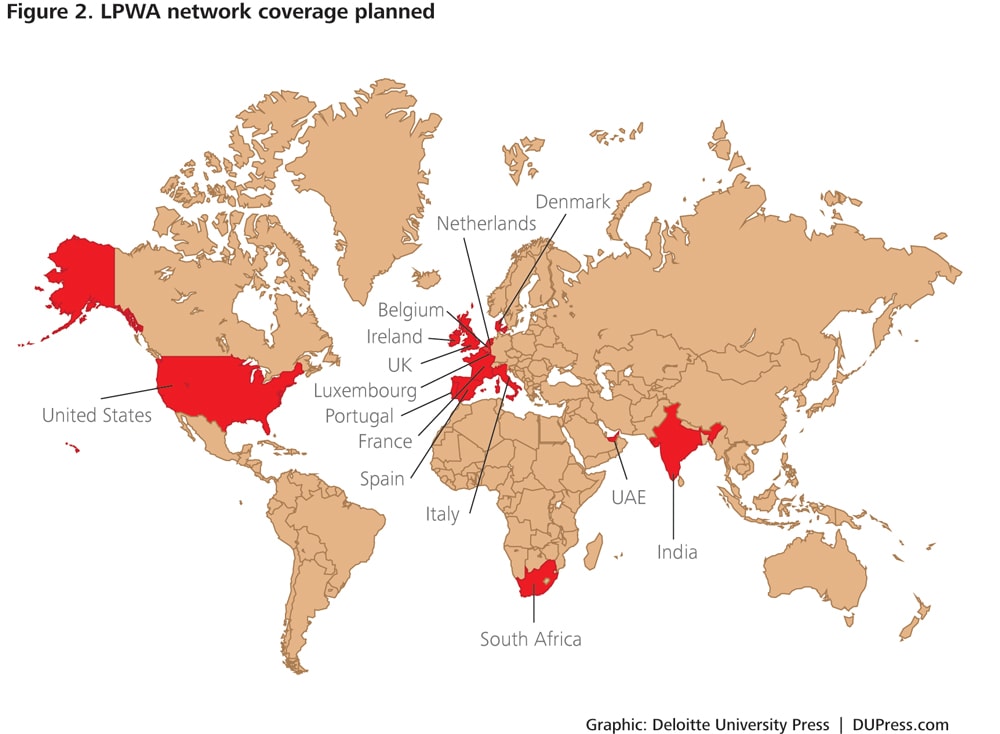Internet of Things has been saved

Internet of Things Dedicated networks and edge analytics will broaden adoption
22 January 2016
Business interest in the Internet of Things continues to grow, with two trends driving an expansion of IoT applications and possibilities: the emergence of new wireless communications networks and the arrival of "edge computing" IT infrastructure.
Signals
- VC investments in startups building dedicated Internet of Things networks more than doubled in 2015, reaching $159 million in the first nine months of the year.1
- Sigfox, an operator of dedicated IoT networks, is extending its network to an 11th European country and aims to cover 10 US cities in Q1 2016.2
- IoT network operator Ingenu raised more than $100 million through September 20153 and plans to deploy dedicated IoT networks in 30 US cities by the end of 2016.4
- Cisco acquired Parstream, a provider of compact, real-time analytics database technology that can be deployed at the edge of a network, close to data sources.5
- In recent months, major technology vendors HPE,6Dell,7 and Intel8 launched edge analytics-focused products including gateways, platforms, and chipsets.
Overview
The Internet of Things (IoT)—the practice of capturing, analyzing, and acting on data generated by networked objects and machines—is among the hottest technology topics in business today.9 While a growing number of companies are creating business value with IoT applications, the technology is still in its early days. Two trends will dramatically expand IoT possibilities in the enterprise, multiplying practical applications while potentially lowering costs:
- The emergence of new wireless communications networks designed specifically for IoT applications, which can lower the cost and extend the reach of connected applications
- The arrival of “edge computing” IT infrastructure, which facilitates analyzing and acting on IoT sensor data close to the source, making applications more responsive to rapidly changing local conditions while avoiding communications bottlenecks
By lowering IoT solutions’ costs, extending their reach, and increasing their responsiveness, these two trends have the potential to significantly expand the kinds of solutions that will be viable for businesses to deploy. While these trends are important, they are not revolutionary. Rather, they can be seen as part of the continuing technological evolution that is bringing the Internet of Things ever closer to ubiquity.
The IoT is already a large and growing market
The global IoT market is poised to grow briskly, from about 4.9 billion connected devices in 2015 to a projected 21 billion by 2020. IoT technology is projected to support $235 billion in services spending in 2016, a majority of that on professional services to design, install, and operate IoT systems.10
Methods of connecting IoT devices can be classified as short-range or long-range. Short-range technologies such as Bluetooth, Zigbee, and Wi-Fi are the dominant choices for IoT connectivity today but are not well suited for every application due to their power requirements and their need for a local hub to connect to, which can be costly or difficult—in consumer applications—for end users to configure. Many other applications require long-range connectivity. Cellular currently dominates the wireless long-range market in the US with 42 million cellular IoT connections in 2014.11 But traditional cellular has its own limitations, such as:
- High connectivity costs: Average cellular connectivity could cost $2.50–3 per device per month and can run to tens of dollars for applications such as connected cars.12
- Propagation: Cellular networks have propagation and coverage limitations in certain environments such as indoor, underground, and remote locations.13
- High capital costs: The investment required to set up new cellular networks can be high.14
- High equipment costs: GPRS modules (for 2G or 3G cellular connectivity) can cost around $10 each; LTE modules (4G) may cost as much as $40 each.15
- Power consumption: Cellular endpoints’ high power consumption necessitates frequent battery replacement, adding complexity and maintenance overheads.16
These cost and performance characteristics mean that cellular is unsuitable for many potentially valuable long-range IoT applications. But networks that promise to overcome these limitations are beginning to proliferate.
Dedicated low-power IoT networks gain steam
A new kind of network, designed specifically to support IoT applications, is spreading across the globe. These networks are known by the generic term low-power wide-area networks (LPWA) and tend to have the following characteristics:17
- Low power consumption by endpoints with extended battery life—often more than 10 years
- Wide area connectivity and higher penetration in dense areas
- Low-cost chipsets and lower cost of network build compared to cellular technology
- Lower connectivity costs—as low as $1–12 annually per device
- Lower throughput capacity compared to cellular networks
These characteristics are well suited for a range of applications in numerous sectors such as agriculture, construction, consumer electronics, health care, environmental, manufacturing, oil and gas, retail and vending, safety and security, smart cities, and utilities. (See table 1.)

We can anticipate a growing number of enterprises to invest in such applications once appropriate networks are in place. These networks could be hugely important for the further development of IoT technology: One analyst firm is forecasting that LPWA network connections will number more than 3 billion devices by 2023, exceeding cellular machine-to-machine connections, becoming the dominant wide-area IoT connectivity technology, and generating connectivity revenues in excess of $10 billion.18 We are already seeing clear signs of the buildout of these networks: More than a dozen companies, backed by significant investment, are building them, employing diverse technologies.
For example, Sigfox, a France-based LPWA network startup, raised $115 million in February 2015 and is seeking another $200–300 million in financing to expand its network for cars, refrigerators, and home-security systems.19 The company recently announced a partnership with the city of San Francisco to deploy an IoT network that will provide low-cost, energy-efficient connectivity for businesses and smart-city programs. The company already operates such networks in 11 European countries and plans to deploy IoT networks in 10 US cities by Q1 2016.20
Another operator helping to build this market is Ingenu (formerly On Ramp Wireless), which specializes in building low-power private networks and plans to create public IoT networks using its proprietary 2.4 GHz Random Phase Multiple Access technology. As of September 2015, Ingenu had raised more than $100 million,21 and the company plans to build public IoT networks in 30 US cities by the end of 2016, with the goal of extending coverage to 70 percent of the American population.22
Semiconductor companies are also investing in supporting LPWA. Silicon Laboratories and Samsung, for instance, are shipping LPWA-network compatible chips.23
Telecom operators recognize the opportunity and are responding by deploying their own LPWA networks or partnering with LPWA network providers. In France, Orange, the largest mobile operator, recently announced plans for a nationwide LPWA network,24 as have operators in other countries: Tata Communications in India,25 du in the United Arab Emirates,26 and Proximus in Belgium.27

Growing adoption of dedicated IoT network-based applications
As dedicated IoT networks spread, they are likely to encourage the adoption of IoT applications where high connectivity costs and higher power consumption of cellular end devices or other limitations of cellular have thus far deterred deployments. Early signs of this include new product introductions and planned deployments in water distribution,28 agriculture,29 smart pet collars,30 municipalities,31 and smart meters and utilities.32 Indeed, we expect the buildout of LPWA to be an important driver of the growth of IoT technology.
Recent IoT deployments using LPWA shed more light on potential applications. For instance, Wellaware, a provider of monitoring and analytics services, is utilizing an LPWA network that covers 55,000 square miles in the United States and supports more than 5,000 endpoints to collect sensor data from clients’ oil fields and chemical facilities, areas often poorly served by cellular networks.33 EnterTrac, a provider of remote monitoring and management services to fuel delivery dealers, is another adopter. It is using an LPWA network for data acquisition from home heating-fuel tank sensors and updating tank dealers on fuel levels several times a day; this can eliminate unnecessary delivery-truck visits to customers, reducing delivery costs by an average of 30 percent, according to the company.34
Analytics on the edge: responding to a flood of IoT data
The Internet of Things, in which billions of devices generate continuous streams of data, threatens to overwhelm the traditional approach for analyzing data. That approach involves transporting data from various sources and locations over a network, storing it in a centralized database, and then performing analysis. As the volume of data increases, so do the complexity and costs of transporting and storing the information and the time required to analyze and act on it. Some IoT scenarios may generate astonishing amounts of data: An aircraft engine, for instance, may generate one terabyte of data per flight.35 The growing edge analytics market—the second trend we highlight here—addresses the challenges of analyzing and reacting to that volume of data.
Edge analytics architectures store, preprocess, and analyze data in a distributed manner, closer to the data source. This approach offers three key benefits:
Reduced network burden and connectivity costs. This is achieved by transporting only relevant data from the edge of the network to the next tier—the cloud or a data center—for further analysis. For example, only in the case of data anomalies or a crossed threshold would the system send data for analysis.
Reduced storage and database management costs. This is achieved by periodically discarding routine data—for instance, operational data showing no anomalies.
Improved real-time analysis and action. Analyzing data close to the source makes it easier to act on the analysis quickly, avoiding the latency involved in sending large amounts of data to the cloud. For example, an energy management company using different sources of power such as renewable and traditional grid generators and battery power can utilize edge analytics at its different locations to optimize usage. If solar energy supply falls in one location, the system automatically increases power supply from another source. If a cheaper source is available, the system shifts to a more optimal source for that location.
Products stream to market
A surge of product introductions indicates the promise of edge analytics. In recent months, Cisco,36 Dell,37 and Hewlett Packard Enterprise (HPE)38 have introduced edge computing devices—primarily gateways, routers, and servers—with greater storage, computing, and analytics capabilities to enable analysis right at the edge of the network. Some edge computing products are designed to withstand industrial temperatures and humidity so that they can be deployed in factory environments.
Deployments show promise
Though adoption of edge analytics is still nascent, early deployments are generating substantial benefits, suggesting that this approach to analyzing and acting on IoT data will grow in importance. For instance, at a Tennessee facility, Tyson Foods implemented a distributed analytics solution that helped improve yields by about 0.10 percent within six weeks of rollout; the project reduced costs enough to pay for itself in just three months.39 The company collects gigabytes of operational data and stores and analyzes it on servers located locally in the factory to provide timely insights to employees, enabling quick decision making and helping to optimize production.40
Envision Energy, a Chinese provider of wind turbines, uses sensor data to improve the productivity of wind farms.41 Each of the company’s 20,000-plus wind turbines is fitted with 150 sensors that collect data such as vibration, temperature, and wind speed. This information is merged with weather data and terrain maps to select the angle and speed of turbine blades that will maximize yield. With more than 3 million sensors, the company produces terabytes of streaming data. For real-time analysis and initiating quick action, Envision Energy is using distributed database technology to store and process this at the edge of its network, helping boost the output of its wind farms by 15 percent.42
Strong growth expected
Many IT and business leaders already recognize the role that edge analytics is going to play in the IoT. In a 2014 Cisco survey of executives in IoT-intensive industries, nearly 40 percent of respondents said “most” of the data produced by their IoT solutions will be processed at the edge of the network—near where it is generated—within the next three years.43 What is different now is the arrival of a wide and growing variety of edge analytics products.
One research firm is forecasting that demand for these intelligent edge devices suited for enterprises and industrial applications will grow at about 20 percent annually over the next six years, generating more than $1 billion in revenues in 2021.44 We anticipate that by alleviating the bottlenecks of traditional analytics architectures, edge analytics products and services are likely to support growing adoption of IoT technology in agriculture, automotive, aviation, manufacturing, oil and gas, retail, smart cities, and utilities, among other areas, over the next 18–24 months and beyond.
Looking forward
These technology trends will make a broader range of IoT applications both feasible and valuable. Leaders who have considered and then shelved plans for an IoT project may want to revisit the business case: Improved economics and improved performance may tip the balance in favor of proceeding. Others who have not seriously evaluated the IoT’s potential for their business may find this is a good time to explore.
These trends have implications for IT leaders as well. In recent years, many enterprises have focused on creating centralized cloud-based data processing and analytics systems. Edge analytics is a fundamentally different approach: In operations where the volume of data generated is high, and speed and responsiveness to local conditions is critical, localized analytics may deliver significant business benefits. A balanced approach, taking advantage of edge analytics and cloud analytics where each is appropriate, is essential.
Taken together, low-cost, low-power IoT networks and edge analytics solutions have the potential to improve the performance and economics of IoT solutions and are likely to hasten enterprises’ adoption of applications. Business and technology leaders may want to review their plans for IoT initiatives with these important trends in mind.
© 2021. See Terms of Use for more information.


